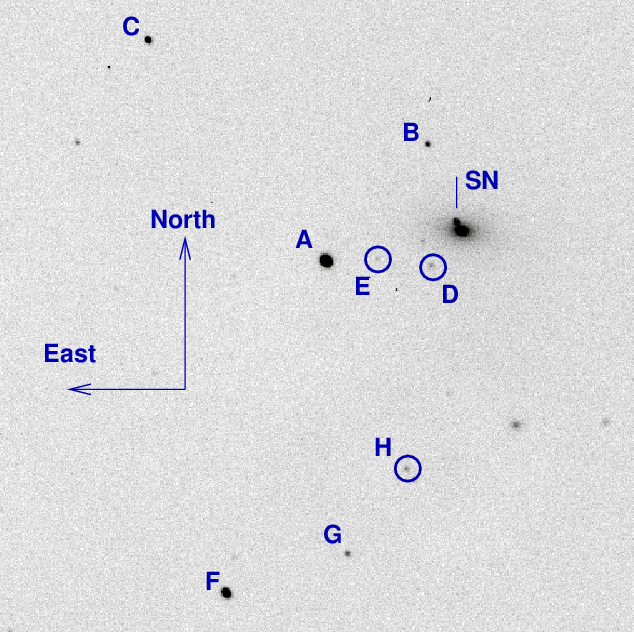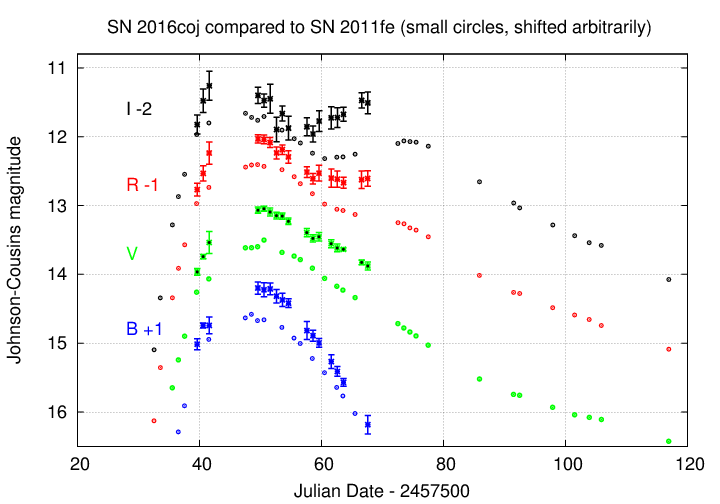
On the night of Jun 27/28, 2016, I observed SN 2016coj in NGC4125, acquiring fewer than usual exposures to beat oncoming clouds.
The main setup was:
Notes from the night
SN 2016coj is a Type Ia supernova in the relatively nearby galaxy NGC4125. It was discovered by the KAIT group some time before maximum light:
NGC 4125 RA = 12:08:05.7 Dec = +65:10:30 (J2000)

The AAVSO sequence team kindly provided photometry for stars near this object. You can see their full photometric sequence on their website. Below, I show only the members of that sequence which fall into my very small field of view -- taken from AAVSO sequence X16266F.
letter B sigB V sigV R sigR I sigI ------------------------------------------------------------------------ B 15.198 0.086 14.133 0.052 13.627 0.116 13.155 0.156 C 13.317 0.093 12.673 0.058 12.316 0.121 11.980 0.161 -------------------------------------------------------------------------
On this night, I took four series of 30-second dark frames: one set right after flats, then three other sets at intervals of 25, 40, 80 minutes after the initial set (the last one after observing the SN). The CCD-TEMP keyword in the FITS header indicated a constant temperature of about -9 degrees Celsius. Despite the constant CCD temperature (if it really WAS constant), the dark current changed -- look at the histogram below.
The initial set has a different (higher) distribution of pixel values than the subsequent three sets, which were all very similar.

Some "hot" pixels did change from set to set.
I decided to combine all the darks in the final 3 sets (a total of 30 frames) to create the master 30-second dark that I would use for the SN images.
I took sets of 6-15 images in each filter, guiding in VRI. I discarded any trailed images. When switching from VR to I, I re-focused the telescope. The FWHM decreased in the focus images from about 4 to about 2.7 pixels, so I guess it was a good idea.
As explained in the notes to Jun 14, 2016, I used the "rotsub" technique to remove the galaxy's light at the position of the SN.
On this night, I used "method 2", which means performing "rotsub" on each individual image, then combining all the resulting images in a passband to make a "master rotsub" image.
Using aperture photometry with a radius of 3 pixels (radius of 4.1 arcsec), I measured the instrumental magnitudes of a number of reference stars and the target. Following the procedures outlined by Kent Honeycutt's article on inhomogeneous ensemble photometry, I used all stars available in each image to define a reference frame, and measured each star against this frame. I used the interim reference magnitudes above plus color terms which I am currently revising -- so please treat these results as preliminary to convert the ensemble instrumental magnitudes to the standard Johnson-Cousins BVRI scale.
Note that in the graph below, I combine data calibrated with UCAC4 photometry (first few weeks) with recent data calibrated with AAVSO photometry. That's inconsistent, and I'll re-compute all magnitudes later.
filter mag mag_uncert Julian Date
SN B = 15.185 +/- 0.136 (ens 0.049 zp 0.127) 2457567.60409
SN V = 13.879 +/- 0.058 (ens 0.025 zp 0.053) 2457567.59433
SN R = 13.607 +/- 0.113 (ens 0.020 zp 0.111) 2457567.59007
SN I = 13.509 +/- 0.159 (ens 0.032 zp 0.156) 2457567.59878
Below is a preliminary light curve, based on RIT Observatory measurements. I also show measurements of SN 2011fe in M101, an ordinary type Ia supernova, shifted arbitrarily.

Last modified 06/28/2016 by MWR.